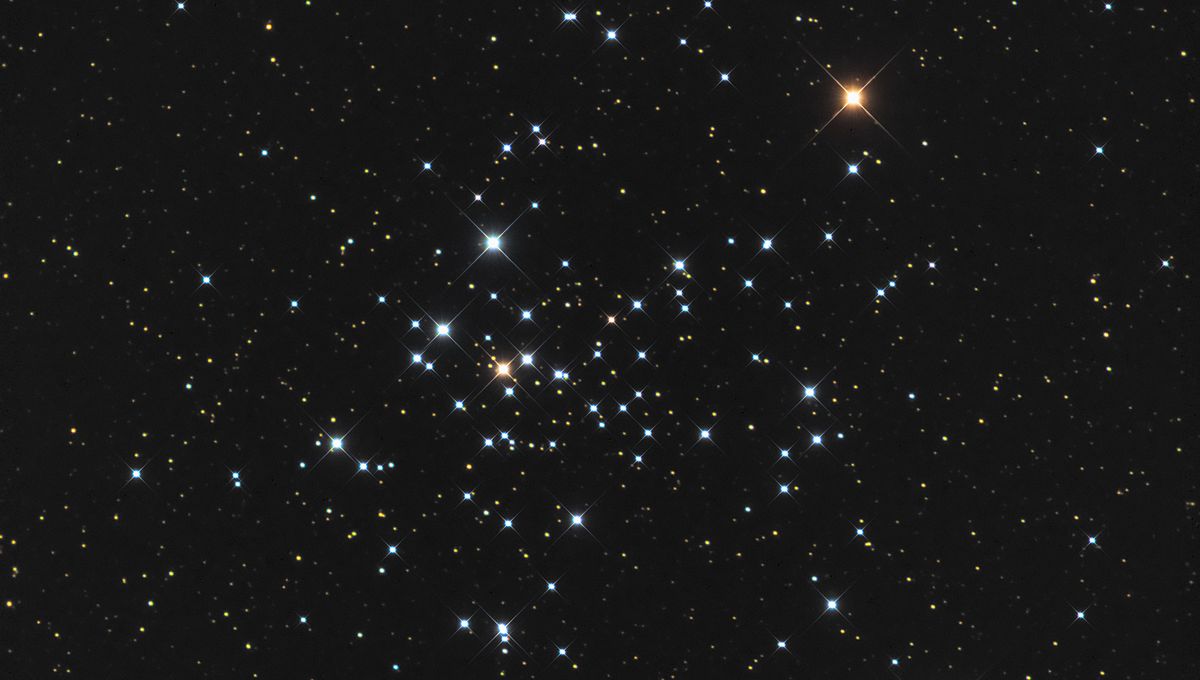
Most stars are formed in dense clusters, but spend the bulk of their lives alone or in pairs. Recently, observations of dissolving clusters have revealed a strange anomaly. The discovery contradicts conventional Newtonian ideas of gravity, but fits with at least one alternative. Still, it takes a lot to overthrow a theory as well founded as Newton’s.
Open star clusters form from large clumps of gas within galaxies and orbit the galactic center. Although some stars can move out the sides, for example if given a push by a nearby supernova, a large proportion eventually either trail behind the cluster or edge ahead, forming long tails in each direction.
According to Newtonian physics, an approximately equal number of stars should become leaders and laggards, and the larger the cluster the more even the split. So, the claim in a new paper that more stars lead the pack than follow, at least within 150 light-years of the cluster center, indicates something very odd is going on. It’s a big leap from that to overthrowing some of the most basic principles of physics, but the paper makes the case for consideration.
“In the clusters we studied the front tail always contains significantly more stars nearby to the cluster than the rear tail,” said Dr Jan Pflamm-Alternburg of the Hemlholz Institute of Radiation and Nuclear Physics in a statement. Determining this fact requires establishing the velocity and age of the stars in each group to distinguish those escaping the cluster from others that happen to be randomly in the galactic vicinity.
The Gaia Space Telescope has now given us the capacity to make those distinctions and the authors have done it for four large clusters, including the famous Hyades and Beehive clusters. Another team did equivalent work for a fifth cluster, which has also been included in the analysis.
It’s possible the excess of stars ahead of the pack is either an error by the authors, or an extreme fluke, like tossing a coin a thousand times and getting 600 heads. If not, however, it would indicate that the laws of motion we have been relying on for almost 400 years are not as universal as was assumed.
It wouldn’t be the first such proposal. Einstein, after all, showed Newton’s laws don’t accurately describe what happens when travelling close to the speed of light or in powerful gravitational fields. Plenty of physicists have subsequently proposed other exceptions.
Most such ideas rapidly fall apart under scrutiny. One that has survived better is known as MOdified Newtonian Dynamics (MOND), created in Mordehai Milgrom in the early 1980s to avoid the need for dark matter to explain the speed of galactic rotation.
“Put simply, according to MOND, stars can leave a cluster through two different doors,” Professor Pavel Kroupa of Pavel University, Prague said. “One leads to the rear tidal tail, the other to the front. However, the first is much narrower than the second—so it’s less likely that a star will leave the cluster through it. Newton’s theory of gravity, on the other hand, predicts that both doors should be the same width.”
The team found that their observations for the cluster dissolution match MOND’s predictions well. This extends not just to the direction in which stars exit, but the speed at which clusters dissolve, which seems to take place more quickly than a pure Newtonian analysis would suggest.
According to MOND, gravitational forces in the outer reaches of galaxies do not weaken with the inverse square law, as occurs within the Solar System. No convincing explanation for why this would be the case exists, and most physicists regard it as improbable. Their skepticism is reinforced by observations of colliding galaxies, which are more in line with predictions that assume classical Newtonian physics and the existence of dark matter.
Puzzling as these observations are for those using dark matter to explain galactic rotation, they’re unlikely to shift how MOND is perceived on their own. However, the authors do make some testable predictions that, if verified, might add to their case.
The work is published in the Monthly Notices of the Royal Astronomical Society
Source Link: Unconventional Alternative To Newtonian Dynamics Explains Star Clusters’ Tails